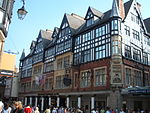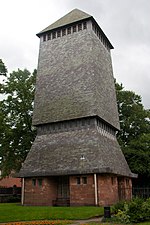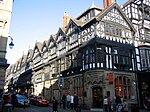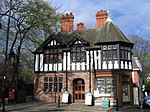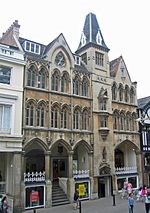Eastgate, Chester

Eastgate is a permanently open gate through the Chester city walls, on the site of the original entrance to the Roman fortress of Deva Victrix in Chester, Cheshire, England. It is a prominent landmark in the city of Chester and the Eastgate clock on top of it is said to be the most photographed clock in England after Big Ben. The original gate was guarded by a timber tower which was replaced by a stone tower in the 2nd century, and this in turn was replaced probably in the 14th century. The present gateway dates from 1768 and is a three-arched sandstone structure which carries the walkway forming part of Chester city walls. In 1899 a clock was added to the top of the gateway to celebrate the diamond jubilee of Queen Victoria two years earlier. It is carried on openwork iron pylons, has a clock face on all four sides, and a copper ogee cupola. The clock was designed by the Chester architect John Douglas. The whole structure, gateway and clock, was designated as a Grade I listed building on 28 July 1955.
Excerpt from the Wikipedia article Eastgate, Chester (License: CC BY-SA 3.0, Authors, Images).Eastgate, Chester
Eastgate Street, Chester Newtown
Geographical coordinates (GPS) Address External links Nearby Places Show on map
Geographical coordinates (GPS)
| Latitude | Longitude |
|---|---|
| N 53.19088 ° | E -2.8888246 ° |
Address
Eastgate
Eastgate Street
CH1 1LR Chester, Newtown
England, United Kingdom
Open on Google Maps


